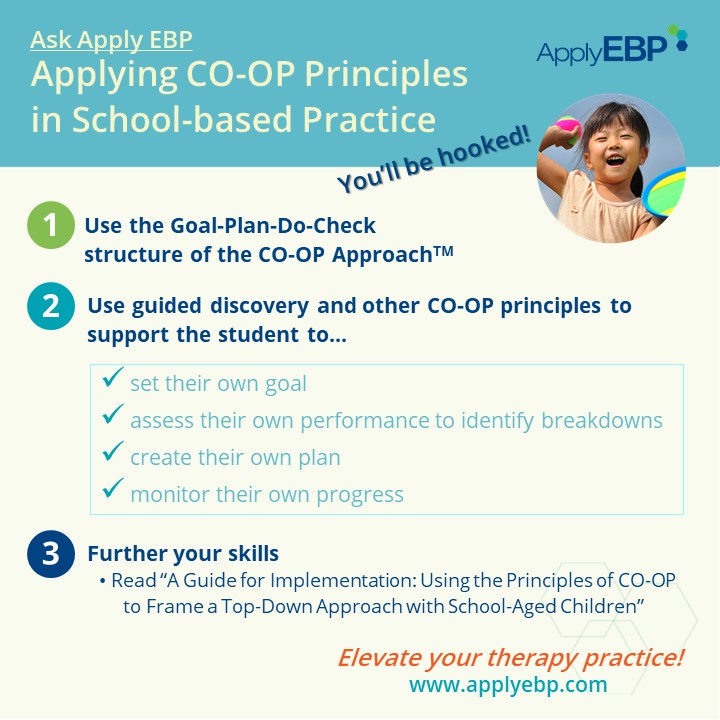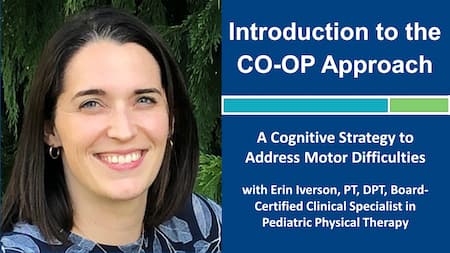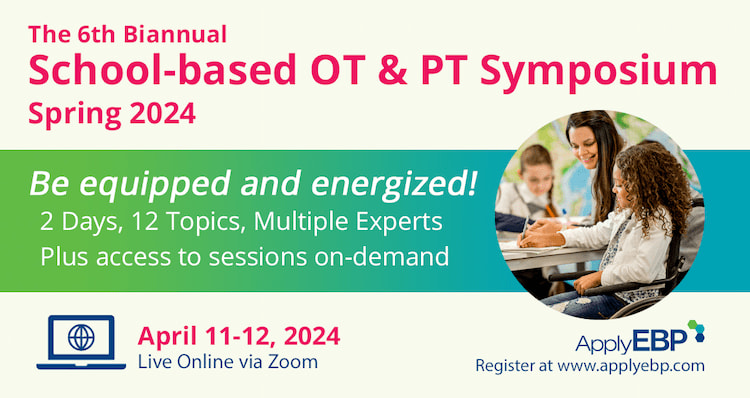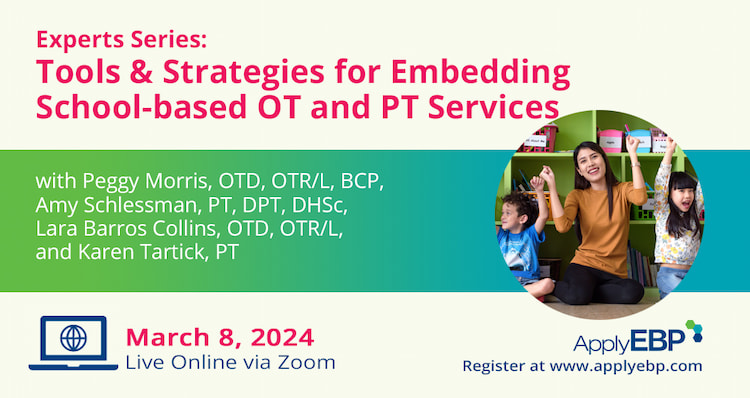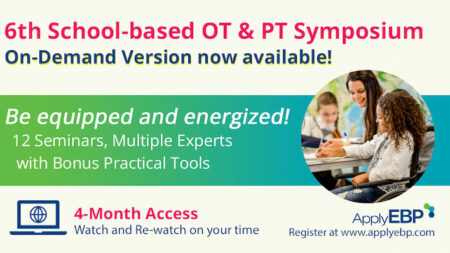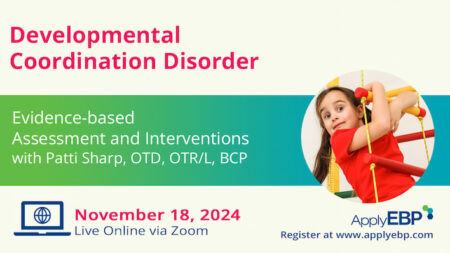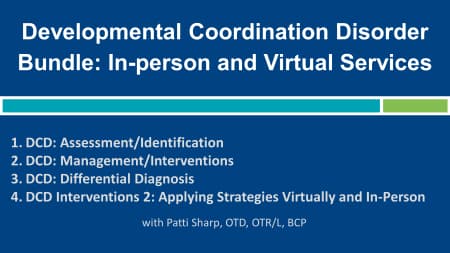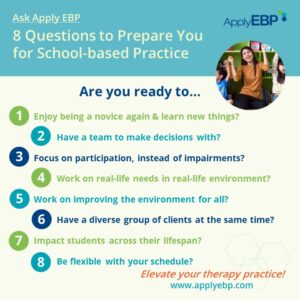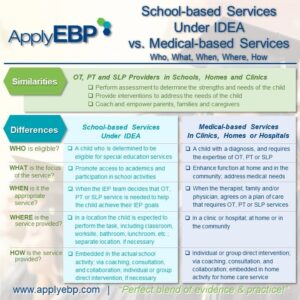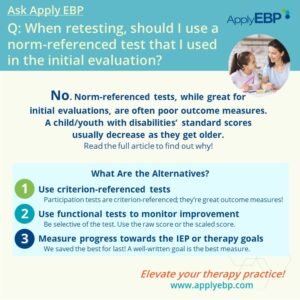Ask Apply EBP
Applying CO-OP Principles in School-based Practice
Question: Is CO-OP useful in school-based practice? If so, how do I use it?
Yes, the principles of the Cognitive Orientation to daily Occupational Performance (CO-OP) ApproachTM are useful in school-based practice. Applying them will make you to rethink how you approach your students and transform the way you practice. Once you try out using the principles, you will be hooked and want to take CO-OP trainings to learn how to use the full Approach.
Before I show you how, it is good to know that CO-OP is an evidence-based practice that has been shown to work for children with different diagnoses (Novak & Honan, 2019). It also meets the American Occupational Therapy Association’s guidelines for best practices (AOTA, 2020). CO-OP can be used by occupational therapy (OT), physical therapy (PT) or other related service/healthcare providers. It is a top-down approach that uses the cognitive strategy of the Goal-Plan-Do-Check to structure interventions (Polatajko & Mandich, 2004). Note that this article is not a full training on CO-OP. We will focus on how to apply the Goal-Plan-Do-Check in school-based practice.
GOAL
The goal is set prior to assessment. The goal should be something your student wants, needs, or is expected to perform. If your student does not initiate a goal, you, as the therapist, you must take the time to understand the expectations on any given task, routine or activity prior to setting goals with the student. While this step can be challenging, school-based therapists are privileged to have direct access to the student and other relevant stakeholders (e.g., teachers, paraprofessionals, parents). Taking the time to collaborate and understand their expectations speeds up identifying the student’s goal. Once you know the expectations, you can guide the student to set a goal using their own words.
By letting the students lead their own goal setting, the resulting goals are more meaningful to them and internally motivating. For example, the student may come up with a goal to be better in throwing a ball into a hoop so they can play with their peers during recess or gym, instead of improving eye-hand coordination; or in zipping up their jacket so they can go out to recess, instead of improving their fine motor skills.
Once the goal is set, you proceed with the assessment. Goal before the assessment?! This may take time to get used to, as this may be in a different order than what you are currently doing. But assessing after allows you to focus on their set goal.
Another thing that is different is that you do not assess performance components (e.g., strength, visual motor skills, or others). Instead, you assess the student’s performance by direct observation of the task using Dynamic Performance Analysis (DPA). It sounds like a fancy term, but it is basically an observation while they are actually doing the task to identify breakdowns in performance. So, if it’s handwriting, you assess them while writing, instead of assessing their visual-motor or fine motor skills.
If possible, you should conduct the DPA process while observing the student’s performance on the set goal within the context in which it is expected to be performed. If it’s handwriting, you observe them in class; if it’s jumping rope, you assess them in recess. Having someone else record the performance is also an option, if you cannot be present in that natural context.
As I mentioned, you observe them to identify breakdowns in performance. For example, if the goal is handwriting, a breakdown you may observe is that the paper is moving while the student is writing. If it’s jumping rope, you may observe that they are not jumping in time with the turn of the rope. These are the breakdowns!
You then use the Performance Quality Rating Scale (PQRS) to rate the initial performance on a scale from 1-10 with 10 being able to perform their tasks as stated in the goal. The PQRS may be a bit subjective in that it depends on your own rating, but if you remember how you rated them initially, it will inform your later PQRS rating as you monitor their progress.
PLAN
Once the breakdowns are identified, you will use guided discovery (and other CO-OP principles) to support the student in seeing the breakdowns for themselves and then identifying strategies to support their own performance. For example, if their paper is moving while they are writing, you might say, “Let’s see if that happens when I write.” You can then exaggerate the paper moving as you write and ask them if they know how to stop it or place your hand in a big motion to draw attention to your hand on the paper. Either way, you guide them to notice what is happening and why it is or isn’t working. Once they identify a strategy for you, you can ask, “I wonder if that would work for you too?”
The student-identified strategies then become a part of their “plan.” This plan should be written using the student’s own words or in a way that the student can follow in their natural environment for that task. For example, a student who has identified that they that they need to hold the paper down may be guided to see if a text, a picture or a symbol would help them follow their plan.
DO
The work does not end there! You will leave their written plan with the student so that in between sessions the student will follow their plan when performing the task as part of their natural routine. To ensure carryover, you will also communicate this to the teacher, teaching assistant, caregivers and others working with the student. Including other adults is essential for supporting success with the student’s initial plan but also for generalization and transfer of skills in the future.
CHECK
Next time you see the student, they will report back to you. Ask whether they were successful and if they followed their plan.
Know that their plan is not static! If they are not fully successful yet, you can guide the student to re-write or add to their plan as needed to support successful performance. The DPA process and guided discovery (and other CO-OP principles) are iterative processes, that you use and re-use until the student’s performance meets their goal.
For example, after the student learns to hold the paper down using their plan, you may identify other breakdowns in their writing, such as holes on the paper due to pushing too hard. You can guide the student to see this breakdown and identify other strategies to add to their writing plan!
During the CHECK stage, you use the PQRS again to document progress. As a student finds success in meeting one goal, they can gain confidence in their ability to succeed with their own plan and be ready to take on new goals!
If you would like to learn more about more ideas on using the CO-OP principles in the school setting,
-
-
- Or attend a CO-OP training, which can lead to you becoming a Certified CO-OP Therapist!
-
Also, for more evidence-informed approaches, join…
THE AUTHOR
Lara Barros, OTD, OTR/L is a school-based OT working in the Chicago suburbs. After working as an OT for over 25 years, she discovered the CO-OP Approach while completing her OTD at NYU and has never looked back. Lara had the privilege of writing this guideline with the mentorship of Dr. Polatjko with the hopes that other school-based therapists will see the value in using CO-OP in their practice.
REFERENCES
-
-
- American Occupational Therapy Association (AOTA) (2020). Occupational therapy practice framework: Domain and process (3rd Edition). American Occupational Therapy Association. UpToDate. Retrieved April 23, 2021 from https://doi.org/10.5014/ajot.2014.682006
- Novak, I. & Honan, I. (2019). Effectiveness of paediatric occupational therapy for children with disabilities: A systematic review. Australian Occupational Therapy Journal, 66, 258-273.
- Polatajko, H.J. & Mandich, A. (2004). Enabling Occupation in Children: The Cognitive Orientation to daily Occupational Performance (CO-OP)Approach. CAOT Publications ACE.
-
Find More Answers to Your Questions in Our...
Featured School
Symposium
6th Online School-based OT and PT Symposium - On-demand Version
- Watch and re-watch on your own time
- On-Demand Version
- OTs, OTAs, PTs and PTAs
- $399-449
Featured Live
Workshop
Developmental Coordination Disorder: Fall 2024
- November 18, 2024, 8:30 am - 3:30 pm Eastern Time
- Online via Zoom
- OTs, OTAs, PTs, PTAs & Educators
- $179-229
Featured On-Demand
Webinar
Intro to the CO-OP Approach
Featured Webinar
Bundle
DCD Bundle: In-person & Virtual Services
Have a question?
Submit here…
*Clicking submit will send your question directly to our email inbox. Your name and email will let us know that your submission is real (not spam). We will not include these in our posts, unless you tell us to include your name. Please read our privacy policy here.
All infographics and videos on www.applyebp.com are intellectual properties of Apply EBP, LLC
You may use the infographics and videos for free for any non-commercial, educational purposes. Please cite the source as “Apply EBP, LLC” and a link to the source article. If you plan to use any infographic or video for commercial purposes (i.e., for profit), please email Carlo@applyebp.com to obtain a written permission. Permission can be granted on a case-by-case basis.

